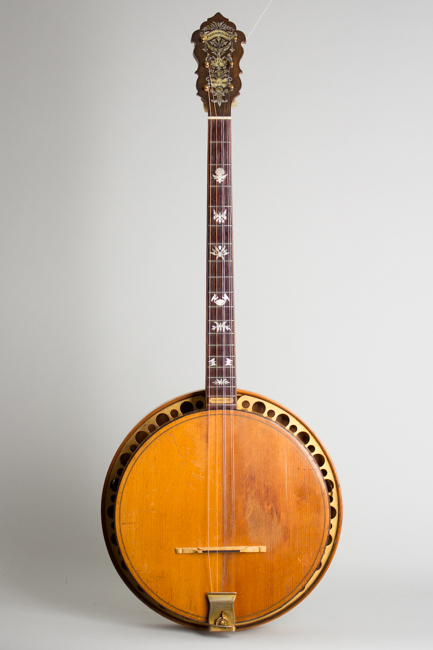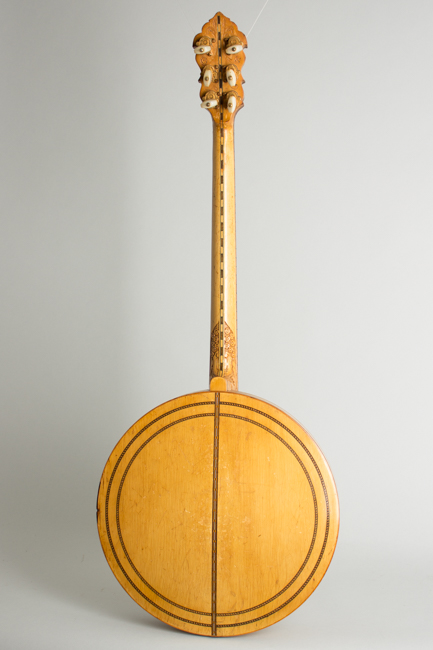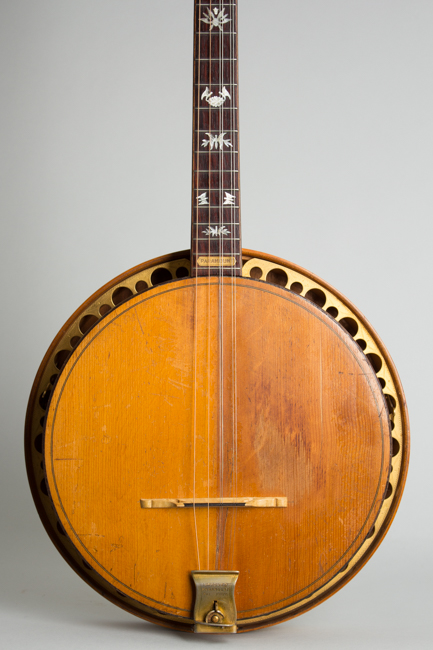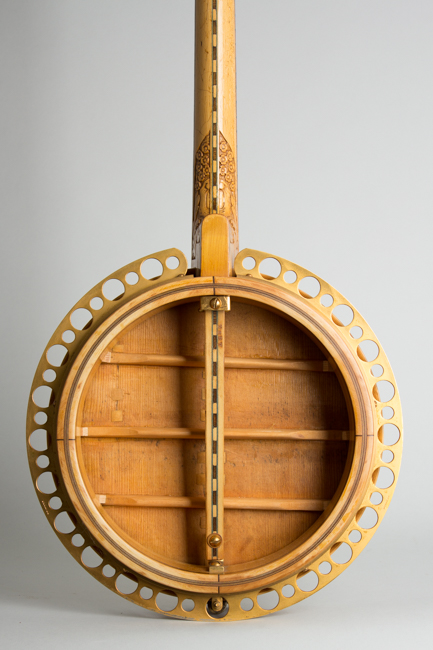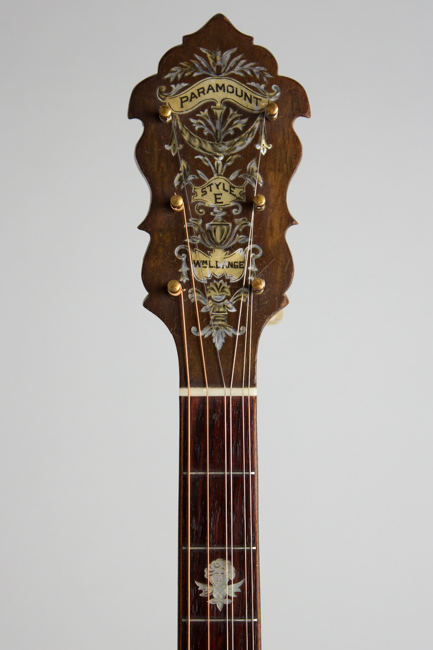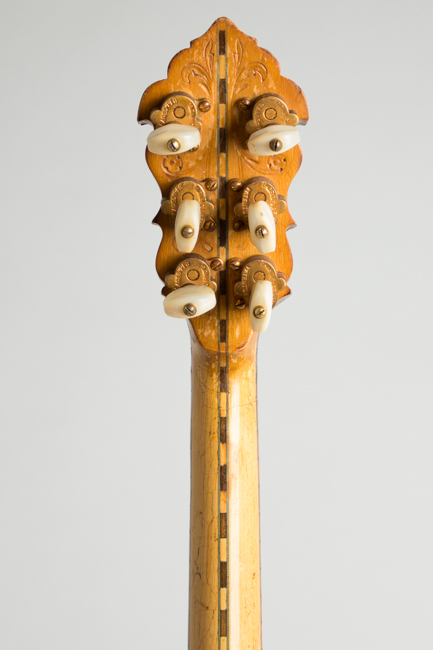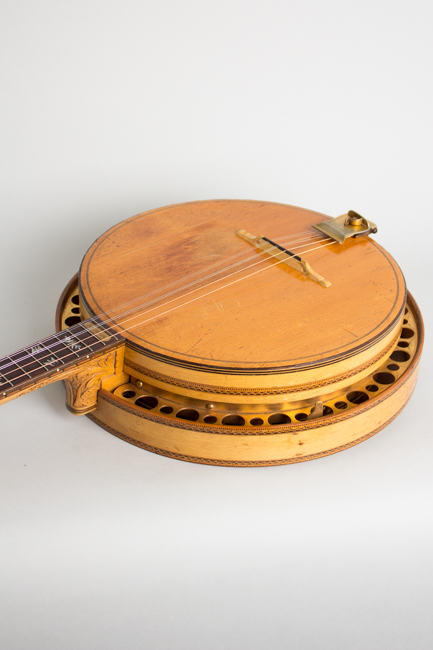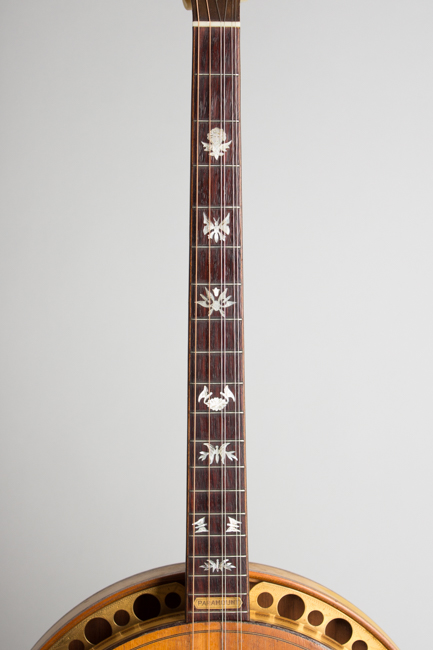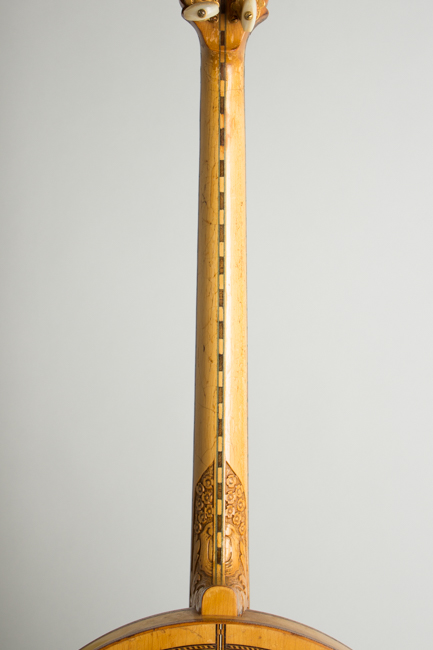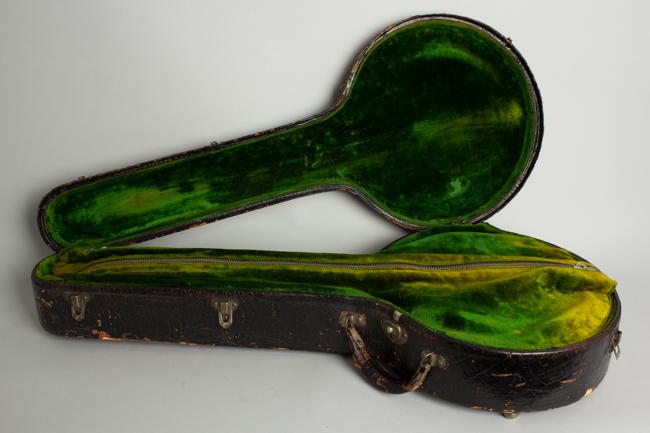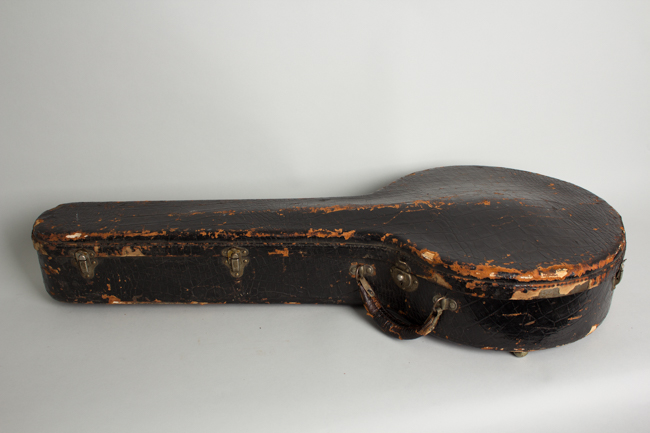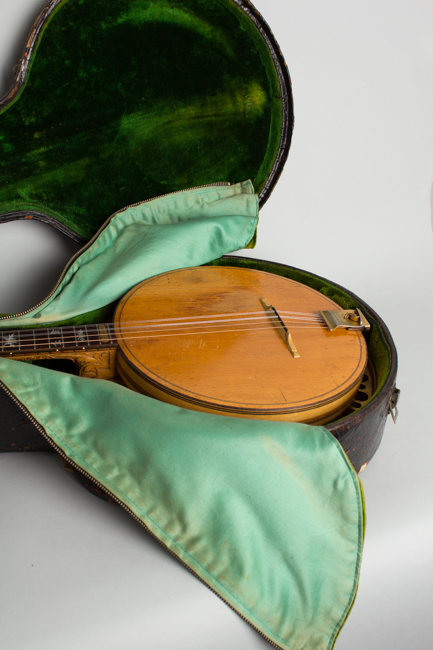Paramount Tenor Harp Style E Wood Top Banjo (1924)
This item has been sold.
Item # 9857
Prices subject to change without notice.
Paramount Tenor Harp Style E Model Wood Top Banjo (1924), made in New York City, serial # 3887, natural varnish finish, laminated maple body and neck, spruce top, rosewood fingerboard, original black hard shell case.
This is simply one of the most unique 1920s instruments we have ever seen, and a true New York jazz-era oddity. While technically neither a banjo nor a 4-string tenor, this Style E Tenor Harp would have been built for a tenor banjoist of some financial means around 1924. It would have served as a doubling instrument for when a mellower tone than the straight banjo was called for. At the time, many banjo players were looking for an instrument that would produce a softer guitar-like sound without the need to learn a whole new fretboard, and several ideas were tried. At Gibson, Lloyd Loar introduced the TL-1 Tenor Lute, a mandola body with a tenor neck, while Paramount simply replaced the banjo head with a spruce plate to create what they called Tenor Harps.
William Lange's banjo factory on East 24th street was the hotbed of banjo innovation in the early 1920s. Many of the features now generally credited to Gibson Mastertone -- in particular the flange and resonator design -- were actually introduced on Lange's Paramount line in 1922-3. Successors to the earlier Rettberg & Lange Orpheum banjos, the new Paramounts were significantly louder with a powerfully incisive tone, perfect for cutting through the brass instruments that dominated the early jazz-era bands. Within a few years, all major banjo companies were building resonator instruments derived from Paramount's designs.
These banjos were all powerful, but even when a mute was employed not particularly good at producing mellow, sustained notes or chords like a guitar. The tenor guitar -- a regular guitar body with four strings -- was the eventual solution, but in the meantime Lange (and New York competitor Epiphone) designed round-bodied banjo-like wooden top tenor instruments. Lange offered a line of these Tenor Harps; simply a banjo rim with no brackets or shoes capped with a head made of spruce. For a company that made nothing but banjos, this design made perfect sense as it used mostly standard components. The Paramount Tenor Harps were cataloged in three basic styles: the Styles 0, 1, and 2, each available with the standard 4-string or a special doubled-up 8-string configuration.
This instrument, however, is none of the above. This is not a standard cataloged "Harp" but an earlier custom order instrument strung with six strings and built on the chassis of a rare and fancy high-end banjo model, the $290 Style E. It carries the same ornamentation as the standard Style E banjo, and uses the same basic rim and resonator parts. It features a multi-laminated white holly neck, rim, and resonator with elaborate carved designs on the heel and the back of the headstock and extensive marquetry decoration.
The gold hardware includes the engraved Paramount flange, the standard patented adjustable-tension tailpiece, and six geared Page tuners. These have genuine pearl buttons and are the finely-made early version with a solidly milled metal housing, not the later fragile castings. The spruce top is built onto a separate cap that fits over the top of the rim, which was a Style E piece but not drilled out for the hook-and-shoe hardware. The maple bridge has an ebony cap and small cutouts on the sides. The neck is chunkier than a standard 4-string style and has a larger headstock to accommodate six banjo tuning pegs, with extremely elaborate engraved pearl inlay on the fingerboard and headstock face.
Playing this beautiful if eccentric instrument is an interesting experience; the treble courses are doubled, like a mandola, but the bottom two are single strung. This may have been intended to beef up the high string response, which might otherwise have sounded fairly thin. It plays very well and tonally really opens up when strummed fairly hard, but of course is not as loud as a banjo. It is light and handy, lacking much of the metal hardware to weigh it down. It must have served its original owner well, as it shows wear from having been played quite a bit long ago. While we don't know who originally ordered this jazz-age oddity, we're glad they did; it's a wonderful example of Paramount craftsmanship and one of the loveliest and most interesting tenor-tuned instruments we have ever seen.
Overall length is 33 1/2 in. (85.1 cm.), 13 in. (33 cm.) across at the widest point, and 3 1/4 in. (8.3 cm.) in depth, measured at side of rim. Scale length is 22 3/4 in. (578 mm.). Width of nut is 1 3/16 in. (30 mm.).
This instrument has been well-played but not abused with some overall finish wear, mostly caused by hard strumming over the top. There is finish checking and dings, dents and scrapes overall. Some of the gold plating is worn down, particularly noticeable on the tailpiece. The only notable repairs are to the spruce top; it was originally fitted with only a single brace spanning the center, and has several repaired cracks in the spruce grain mostly near the center seam. This somewhat inadequate bracing has been augmented with two light cross braces fore and aft added to strengthen it. Many of these lightly built "harps" have issues in this area, but this one is now a solid played and good for another century.
The neck has remained very straight and what appear to be the original frets show very little wear. The nut has been replaced. The instrument is lots of fun to play, and capable of all sorts of sounds beyond its 1920s tenor jazz band roots. A nice period package if an eccentric one, this instrument still resides in the original Paramount high-end banjo case, well-worn but still fully functional. Excellent - Condition.
This is simply one of the most unique 1920s instruments we have ever seen, and a true New York jazz-era oddity. While technically neither a banjo nor a 4-string tenor, this Style E Tenor Harp would have been built for a tenor banjoist of some financial means around 1924. It would have served as a doubling instrument for when a mellower tone than the straight banjo was called for. At the time, many banjo players were looking for an instrument that would produce a softer guitar-like sound without the need to learn a whole new fretboard, and several ideas were tried. At Gibson, Lloyd Loar introduced the TL-1 Tenor Lute, a mandola body with a tenor neck, while Paramount simply replaced the banjo head with a spruce plate to create what they called Tenor Harps.
William Lange's banjo factory on East 24th street was the hotbed of banjo innovation in the early 1920s. Many of the features now generally credited to Gibson Mastertone -- in particular the flange and resonator design -- were actually introduced on Lange's Paramount line in 1922-3. Successors to the earlier Rettberg & Lange Orpheum banjos, the new Paramounts were significantly louder with a powerfully incisive tone, perfect for cutting through the brass instruments that dominated the early jazz-era bands. Within a few years, all major banjo companies were building resonator instruments derived from Paramount's designs.
These banjos were all powerful, but even when a mute was employed not particularly good at producing mellow, sustained notes or chords like a guitar. The tenor guitar -- a regular guitar body with four strings -- was the eventual solution, but in the meantime Lange (and New York competitor Epiphone) designed round-bodied banjo-like wooden top tenor instruments. Lange offered a line of these Tenor Harps; simply a banjo rim with no brackets or shoes capped with a head made of spruce. For a company that made nothing but banjos, this design made perfect sense as it used mostly standard components. The Paramount Tenor Harps were cataloged in three basic styles: the Styles 0, 1, and 2, each available with the standard 4-string or a special doubled-up 8-string configuration.
This instrument, however, is none of the above. This is not a standard cataloged "Harp" but an earlier custom order instrument strung with six strings and built on the chassis of a rare and fancy high-end banjo model, the $290 Style E. It carries the same ornamentation as the standard Style E banjo, and uses the same basic rim and resonator parts. It features a multi-laminated white holly neck, rim, and resonator with elaborate carved designs on the heel and the back of the headstock and extensive marquetry decoration.
The gold hardware includes the engraved Paramount flange, the standard patented adjustable-tension tailpiece, and six geared Page tuners. These have genuine pearl buttons and are the finely-made early version with a solidly milled metal housing, not the later fragile castings. The spruce top is built onto a separate cap that fits over the top of the rim, which was a Style E piece but not drilled out for the hook-and-shoe hardware. The maple bridge has an ebony cap and small cutouts on the sides. The neck is chunkier than a standard 4-string style and has a larger headstock to accommodate six banjo tuning pegs, with extremely elaborate engraved pearl inlay on the fingerboard and headstock face.
Playing this beautiful if eccentric instrument is an interesting experience; the treble courses are doubled, like a mandola, but the bottom two are single strung. This may have been intended to beef up the high string response, which might otherwise have sounded fairly thin. It plays very well and tonally really opens up when strummed fairly hard, but of course is not as loud as a banjo. It is light and handy, lacking much of the metal hardware to weigh it down. It must have served its original owner well, as it shows wear from having been played quite a bit long ago. While we don't know who originally ordered this jazz-age oddity, we're glad they did; it's a wonderful example of Paramount craftsmanship and one of the loveliest and most interesting tenor-tuned instruments we have ever seen.
Overall length is 33 1/2 in. (85.1 cm.), 13 in. (33 cm.) across at the widest point, and 3 1/4 in. (8.3 cm.) in depth, measured at side of rim. Scale length is 22 3/4 in. (578 mm.). Width of nut is 1 3/16 in. (30 mm.).
This instrument has been well-played but not abused with some overall finish wear, mostly caused by hard strumming over the top. There is finish checking and dings, dents and scrapes overall. Some of the gold plating is worn down, particularly noticeable on the tailpiece. The only notable repairs are to the spruce top; it was originally fitted with only a single brace spanning the center, and has several repaired cracks in the spruce grain mostly near the center seam. This somewhat inadequate bracing has been augmented with two light cross braces fore and aft added to strengthen it. Many of these lightly built "harps" have issues in this area, but this one is now a solid played and good for another century.
The neck has remained very straight and what appear to be the original frets show very little wear. The nut has been replaced. The instrument is lots of fun to play, and capable of all sorts of sounds beyond its 1920s tenor jazz band roots. A nice period package if an eccentric one, this instrument still resides in the original Paramount high-end banjo case, well-worn but still fully functional. Excellent - Condition.
